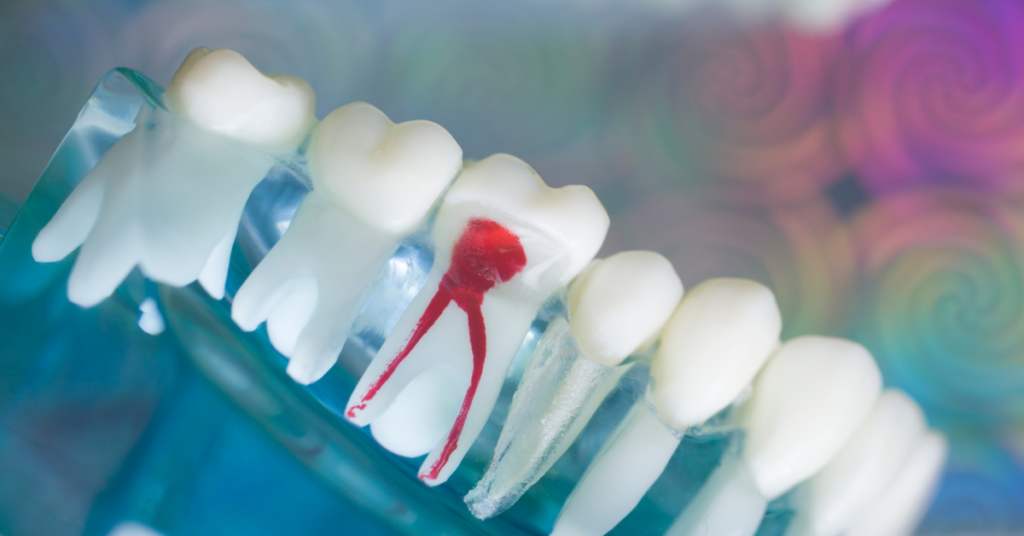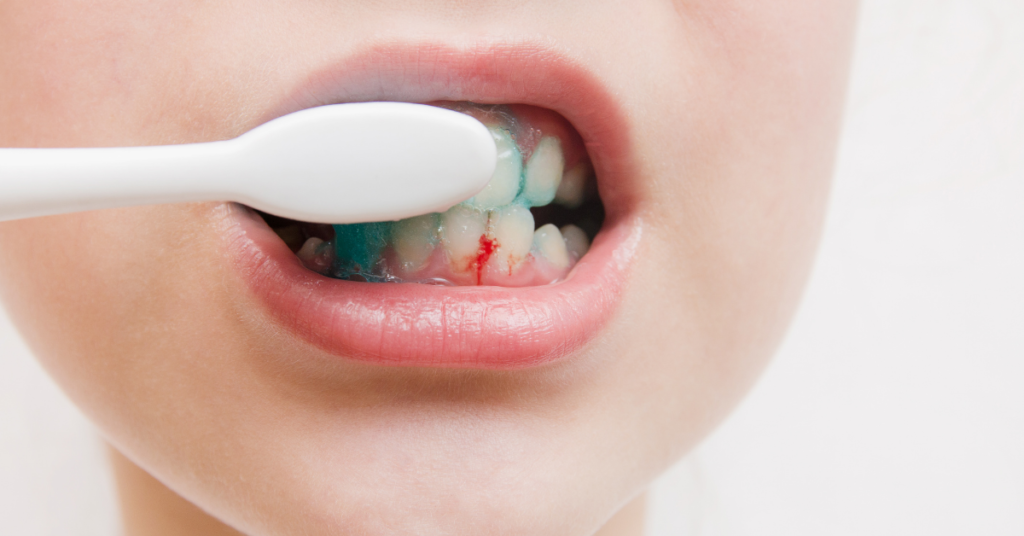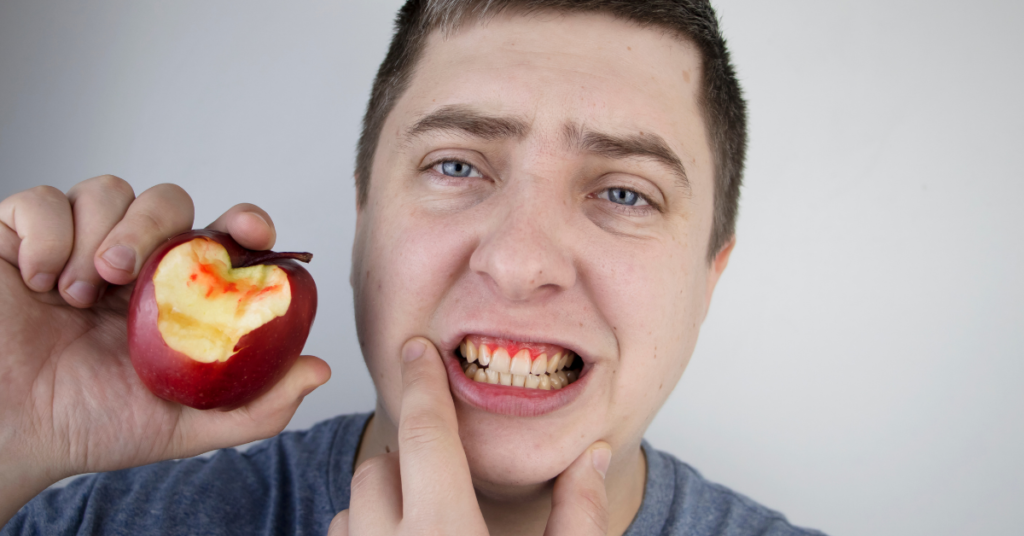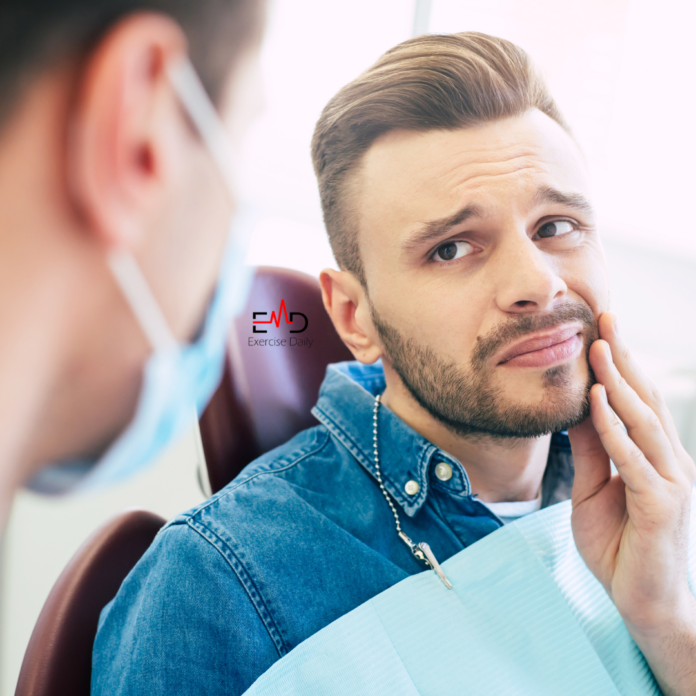Table of Contents
Exercise Daily – Bruise on gums can be a result of many unexpected conditions like flossing too hard, fall on your face, or eating something hard.
In the course of our daily activities, we may do something that results in a bruise, such as bumping into something or otherwise injuring ourselves, which is common.
In the same way that we may get a bruise on our bodies, we can get a bruise on our gums.
Bruises on the gums can be any color; they can be dark brown, black, red, or purple in shades. They can also be any size. In addition to bruising and discomfort, it has been reported that there is also bleeding.
Causes of Bruise on Gums
The following are some of the reasons for bruised gums:
Flossing Forcefully
Cleaning your teeth with dental floss is an important part of keeping your mouth and gums healthy. It is critical to floss regularly in order to avoid plaque accumulation and deterioration in your tooth enamel.
The use of pre-threaded flossers, water floss, and dental floss are all examples of different types of flossing methods.
Most people use dental floss. However, there are instances when the gums may be sensitive or when a person flosses too firmly against them.
This has the potential to induce bleeding and bruises. Another possibility is that the bleeding and bruises are the results of another medical issue.
To avoid bruise on gums while flossing, try Oral-B Water Flosser Advanced.
Oral-B Water Flosser Advanced
In order to help remove plaque bacteria and promote healthier gums, its exclusive oxyjet technology uses water that has been enriched with microbubbles of air.
The cordless handle is powered by a long-lasting rechargeable battery, making it portable and ideal for thorough cleaning. The on-demand button allows you to have greater control while creating less mess.
Personalized streams enable for more tailored cleaning: multi-jet for an all-around clean, concentrated for targeted cleaning, and rotating for gum massage, among other options.
When taken in conjunction with brushing, flossing, and regular professional treatment, it can aid in the reduction of plaque bacteria and the inflammatory components associated with gingivitis.
Having a Fall on your Face
Bruising of the gums might occur as a result of a fall or an accident. When someone falls on their face, it can cause bruising of the gums depending on their age and the sort of activity they are doing in (sports, tripping, or weak bones), among other things.
The bruising is caused by the rupture or tear of tiny blood vessels under the skin’s surface.
As soon as you realize you’ve been hurt on your face and you have bruise on gums, inspect the rest of your face and mouth to determine whether you’ve sustained any other injuries or bruises.
Chipped teeth, as well as injury to the lips, jaw, and other parts of the face and mouth, are possible consequences of a dental accident. In the case of mild injuries, applying ice to the bruised region should be beneficial.
Eating Sharp Foods
Gum bruising can also be caused by eating something sharp or crunchy or by poking your mouth with a sharp instrument while you’re eating.
When you bite into a crispy chip, use a toothpick, or eat with a fork or skewer, any of these actions might result in an unintentional poke that can cause bruising and bleeding.
Injury to the Mouth
When there is a trauma or damage to the mouth, the gums might bleed and bruise.
As a result of a blow to the lips, an accident, or a fall, bruises and swelling will occur, which may be severe depending on the circumstances. It may also take some time for the wound to heal.
Bruise on gums are not the only type of damage that can develop as a result of trauma or injury; other injuries can occur as well, including broken or fractured bones, a dislocated jaw, and cuts within the mouth or on the lips.
If you have suffered an injury or damage to your mouth, get medical attention immediately to ensure that you receive the correct diagnosis and treatment.
Teething in Kids
In most cases, a baby’s first teeth will appear between the ages of 6 months and one year old. A newborn is born with 20 teeth below the gumline, and by the age of three, the majority of a child’s baby teeth have emerged.
When teething begins, and the teeth begin to emerge, the gums become sensitive and bleed easily, causing bruising and bleeding. This might occur as a result of the teething process itself or as a result of the things that newborns use to comfort their gums.
Thrombocytopenia
Thrombocytopenia is a condition that is characterized by a low platelet count (thrombocytopenia). The body does not have enough platelets to create a blood clot at the site of a wound or cut, which can assist in halting the flow of blood.
If a person with this disease is hurt or cut, there may be a lot of bleeding because the platelets are low, and the blood cells are unable to clump together to form clots to help stop it from bleeding further.
This might result in the individual bleeding excessively. Gum bleeding, bruising quickly, and purple, brown, or red bruises are just a few of the symptoms you may experience if you suffer from this condition.
Diagnosis of Bruise on Gums

There are a few variables to consider while determining the cause of your bruised gums. The following are some of the reasons:
- Injury
- Trauma
- Eating something scratchy
- Gingivitis
It all depends on why your gums are bruised as which doctor you should go see.
You should see your primary care physician if you have fallen and your injury is small enough that you should arrange an appointment with them.
They can assist you in determining the nature of your injury and send you to a specialist if necessary. If the damage is severe, get immediate medical attention.
A pediatrician would examine a teething child and maybe send them to a dentist if necessary.
If the bruising of the gums is caused by a problem that is unique to the mouth and teeth, a dentist may assist you in identifying the problem and providing a diagnosis as well as a recommended treatment strategy.
A doctor or dentist will generally ask you questions about your symptoms and, depending on the severity of the damage, may recommend X-rays.
When a patient has thrombocytopenia, a doctor will do a physical exam as well as a blood clot and blood count test to diagnose the disease.
If the platelet count is low, the doctor may also order a bone marrow biopsy to determine if the patient has cancer or a condition of the bone marrow, among other things.
The doctor may also prescribe imaging tests, such as computed tomography (CT) scan or an ultrasound, to look for enlargement of the lymph nodes, swelling of the spleen, or evidence of liver cirrhosis.
Treatment of Bruise on Gums

The treatment of swollen gums varies based on the diagnosis and the reason for the swelling and may include one or more of the following:
- If there is only slight bruising, it will usually go away on its own in time.
- A cold compress and the consumption of softer meals would be beneficial.
- Hard meals should be avoided by babies who are teething.
- Other methods of treating the gums include using a tiny cold spoon, a moist gauze pad, or a clean finger to massage the area.
Depending on the severity of thrombocytopenia, the doctor may recommend a blood transfusion to boost the platelet count.
It will be necessary to transfuse blood if the platelet counts are dangerously low. The normal level of platelets per microliter of blood is 150,000 platelets per microliter of blood.
The doctor may recommend that the spleen be surgically removed. Steroids, such as immunoglobulins or antibody proteins, as well as other medicines that are known to assist increase platelet formation and prevent the death of platelets, are also available as options for treating atherosclerosis.
How to Deal with Gum Pain
If you are experiencing gum pain, there are several things you can do on your own to help alleviate the discomfort, including:
- Keeping items that are crunchy or have sharp edges to a minimum
- Using a gentle toothbrush
- Flossing with care
- Using warm salt water to rinse your mouth
If you are experiencing gum discomfort, over-the-counter medicines like Tylenol or Motrin can provide relief. If the pain is severe, contact your dentist or doctor immediately so that they can assist you in making the best treatment selection possible.
10 Best Home Remedies for Bruised and Painful Gums

The following are the 10 best home remedies to treat bruise on gums:
Using Compresses (both warm and cold)
A simple and effective method of relieving bruised and swollen gums is to apply compresses to the area where the discomfort is present. Compresses, whether hot or cold, will suffice.
Hot Compress: Bring some water to a boil, but avoid bringing it to a full boil. You should be able to endure the water if it is sufficiently hot.
Take a clean towel and soak it in water for a few minutes. Squeeze off any excess water and lay the cloth on your face in the area where the gum pain is present.
Cold Compress: Wrap an ice pack in a clean towel and apply it in the same way as a hot compress to relieve pain.
You can alternate the use of both compresses until the discomfort and swelling have subsided completely.
Using Salt Water to Rinse
Saltwater rinses are an excellent home treatment for relieving sore gums and are easy to make. The salt in the water inhibits the growth of germs and aids in the elimination of the bacteria that is already present in your mouth.
Starting with a cup of water that has been warmed but not yet reached boiling point, add 1 teaspoon of salt and stir well. Swish the saltwater about in your mouth for a few seconds, then spit it out into the sink to remove the saltwater.
Don’t forget to keep the water out of your mouth! Rinse your mouth with salt water at least twice a day to keep your mouth healthy.
It is an effective cure for bruise on gums.
Hydrogen Peroxide (H2O2)
The hydrogen peroxide aids in the relief of discomfort and the reduction of gingivitis. Hydrogen peroxide is an excellent germ-killing agent that may also be used to treat a variety of other oral health concerns.
To begin, combine equal amounts of water and hydrogen peroxide in a mixing bowl. Spit on a sink after swishing the peroxide solution in your mouth for about 20 seconds, then rinse your mouth with warm water to remove the peroxide solution.
Another method of utilizing hydrogen peroxide is to combine it with baking soda to form a paste. Apply the paste to the inside of your mouth, wait a minute, and then rinse it out with water.
Tea Bags
Prepare a tea bag by soaking it in boiling water for at least 5 minutes, just as you would if you were making tea. Allowing the tea bag to cool for a few minutes will ensure that it is not searing hot when applied to the afflicted gums.
Try to select a type of tea that has astringent qualities, such as green or black tea or hibiscus tea, rather than a generic variety. Selecting a tea with anti-inflammatory qualities, such as chamomile or ginger, is also a viable option.
Teabags are an excellent method to treat bruise on gums.
Tea Tree Oil
Tea tree oil is well-known for its anti-inflammatory and antibacterial qualities that are derived from nature. It is ideal for relieving the discomfort of your inflamed gums and other dental problems.
To use, add a few drops of tea tree oil to a glass of water and gargle with it as you would with any other mouthwash.
You may also attempt to get toothpaste that contains tea tree oil to see if that provides any further benefit.
Turmeric Paste
Besides turmeric, which has antioxidant and anti-inflammatory effects, there are many more natural ingredients to consider. When used topically, turmeric can help to decrease the swelling, discomfort, and inflammation of your gums.
1/4 teaspoon of turmeric should be mixed with a little water until a paste is formed. This is the final step.
Apply the solution to your afflicted gums and allow it to sit for 5 minutes. Take care to gently massage it into your gums with circular strokes to avoid irritation.
After that, be sure to thoroughly rinse away any turmeric residue with warm water. For 1 to 2 weeks, or until the discomfort is gone, repeat the procedure every day for 1 to 2 weeks.
Pain Relievers (OTC)
If pain is coming in the way of your activities, you might consider trying quick pain relief. Some over-the-counter analgesics will suffice in this situation.
Pain medications such as aspirin, acetaminophen, and ibuprofen can be used to alleviate the discomfort. These may be purchased at your local pharmacy or grocery shop.
You can increase the efficacy of the painkillers by combining them with other home remedies to treat bruise on gums.
Anaesthetic Gels for Oral Use
You can also use over-the-counter oral anesthetic gels to relieve your gum pain if you are experiencing discomfort.
These gels include a combination of natural and synthetic substances that work together to numb your gums and provide pain relief.
Natural pain remedies such as clove and Spilanthes are commonly found in oral gels. Orajel and Anbesol are two anesthetic gels that are commonly available over-the-counter.
Dental Spray Made at Home
If you want to produce a dental spray to relieve your gum discomfort, you may do it by utilizing essential oils as the primary ingredient.
Fill a new and clean spray bottle with clean water (be sure no other product has been placed in it previously).
You’ll need around 5 drops of the essential oils of your choice to complete this recipe. Oregano, peppermint, and clove essential oils are excellent choices because they have pain-relieving and anti-inflammatory properties.
Spray the solution straight into your gums twice a day for the first several days, then every day until your condition improves.
Improve your Nutritional Intake
In order to avoid sore and inflamed gums in the first place, it is necessary to take preventative measures.
Improving your nutrition is a wonderful strategy to prevent and enhance gum disease and gum health. Begin by include calcium, vitamin C, and folic acid in your diet on a regular basis.
If you do not get enough of these vitamins in your diet, it is possible that your gums could get inflamed and you get bruise on gums.
Several foods contain vitamin C, including broccoli, bell peppers, oranges, pineapple kale kiwi, and strawberries. Vitamin C may also be found in citrus fruits such as oranges, pineapple kale, and strawberries.
Getting the proper quantity of calcium can have a variety of positive effects on your overall dental health. Calcium may be found in a variety of foods, including dairy products, soy milk, tofu, sardines, cereals, and collard greens.
Beans, lentils, broccoli, asparagus, greens, peas, and avocados are all good sources of folic acid to include in your diet.
When Should You See a Healthcare Professional?
If you have bruising, that has been caused by a fall, a strike, or a severe injury. You should see a doctor right away.
If you notice that your gums are not improving, or if they are very bruised, discolored, bleeding, or painful, you should schedule an appointment with your dentist as soon as possible.
A doctor or dentist can assist you in getting an accurate diagnosis of your illness and in determining the best treatment choices for you.
There are a variety of factors that contribute to bruised gums. The majority of mild occurrences of bruising will resolve on their own.
If you have bruising, that is connected with a health condition or an injury that produced it. A healthcare practitioner can assist you in diagnosing and treating the problem.
Bruise on Gums – FAQs
How do you heal a bruised gum?
A warm compress or warm herbal teas can be used to soothe small bruises. Rinsing the mouth with salt water can also be helpful.
Furthermore, if bruises appear on their own and you are unsure of what caused them, it is preferable that you get treatment for the bruised gums.
How long does it take for gum bruises to heal?
A slight cut on the gums should heal within 3 to 4 days, depending on the severity of the injury. If the cut is more serious and requires stitches, or if it becomes infected, the expected healing period may be longer than anticipated.
What causes dark spots on your gums?
It’s likely that those small patches have always been there; black gums are generally genetic in nature.
The majority of persons who have black gums have a higher concentration of melanin in their skin than those who do not have dark gums.
The melanin in the gums might manifest itself as blotchy patches. In rare circumstances, smoking can also result in “black gums.”
Do gums bruise when teething?
When your baby’s teeth begin to erupt – which can occur anywhere between 3 and 12 months of age, and even later – keep an eye out for darkening of the gums, known as eruption cysts, as well bruising along their gum lines.
It’s essential to understand that they are not harmful and are simply indicators of new teeth coming in.
Is it possible to bruise gums?
You may get bruise on gums in the same way that you can injure any other part of your body. Bruising your gums can occur as a result of falling on your face, eating anything with sharp edges, or even cleaning or flossing your teeth too forcefully.
In most cases, bruises on the gums are dark red or purple in color, although they can also be dark brown or black in color.
What does a bruised gum feel like?
Some of the most common signs and symptoms of a damaged tooth include discoloration, sensitivity, inflammation, bleeding of the gums, and persistent toothache or pain.
In many cases, the ligaments that support the afflicted area and function as shock absorbers to cushion and protect your teeth can feel a lingering discomfort as a result of the hit.










